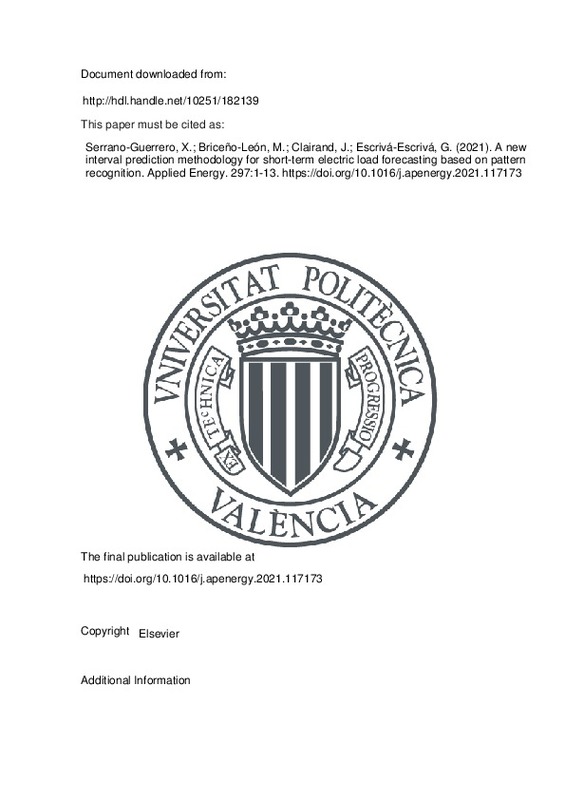JavaScript is disabled for your browser. Some features of this site may not work without it.
Buscar en RiuNet
Listar
Mi cuenta
Estadísticas
Ayuda RiuNet
Admin. UPV
A new interval prediction methodology for short-term electric load forecasting based on pattern recognition
Mostrar el registro sencillo del ítem
Ficheros en el ítem
| dc.contributor.author | Serrano-Guerrero, Xavier
|
es_ES |
| dc.contributor.author | Briceño-León, Marco
|
es_ES |
| dc.contributor.author | Clairand, Jean-Michel
|
es_ES |
| dc.contributor.author | Escrivá-Escrivá, Guillermo
|
es_ES |
| dc.date.accessioned | 2022-04-27T06:28:05Z | |
| dc.date.available | 2022-04-27T06:28:05Z | |
| dc.date.issued | 2021-09-01 | es_ES |
| dc.identifier.issn | 0306-2619 | es_ES |
| dc.identifier.uri | http://hdl.handle.net/10251/182139 | |
| dc.description.abstract | [EN] Demand prediction has been playing an increasingly important role for electricity management, and is fundamental to the corresponding decision-making. Due to the high variability of the increasing electrical load, and of the new renewable energy technologies, power systems are facing technical challenges. Thus, short-term forecasting has crucial utility for generating dispatching commands, managing the spot market, and detecting anomalies. The techniques associated with machine learning are those currently preferred by researchers for making predictions. However, there are concerns regarding limiting the uncertainty of the obtained results. In this work, a statistical methodology with a simple implementation is presented for obtaining a prediction interval with a time horizon of seven days (15-min time steps), thereby limiting the uncertainty. The methodology is based on pattern recognition and inferential statistics. The predictions made differ from those from a classical approach which predicts point values by trying to minimize the error. In this study, 96 intervals of absorbed active power are predicted for each day, one for every 15 min, along with a previously defined probability associated with the real values being within each obtained interval. To validate the effectiveness of the predictions, the results are compared with those from techniques with the best recent results, such as artificial neural network (ANN) long short-term memory (LSTM) models. A case study in Ecuador is analyzed, resulting in a prediction interval coverage probability (PICP) of 81.1% and prediction interval normalized average width (PINAW) of 10.13%, with a confidence interval of 80%. | es_ES |
| dc.language | Inglés | es_ES |
| dc.publisher | Elsevier | es_ES |
| dc.relation.ispartof | Applied Energy | es_ES |
| dc.rights | Reconocimiento - No comercial - Sin obra derivada (by-nc-nd) | es_ES |
| dc.subject | Electricity demand | es_ES |
| dc.subject | Pattern recognition | es_ES |
| dc.subject | Prediction intervals | es_ES |
| dc.subject | Short-term forecasting | es_ES |
| dc.subject.classification | INGENIERIA ELECTRICA | es_ES |
| dc.title | A new interval prediction methodology for short-term electric load forecasting based on pattern recognition | es_ES |
| dc.type | Artículo | es_ES |
| dc.identifier.doi | 10.1016/j.apenergy.2021.117173 | es_ES |
| dc.relation.projectID | info:eu-repo/grantAgreement/Universidad de las Américas, Ecuador//IEA.JCG.20.01//Advanced control strategies and management in a microgrid/energy hub/ | es_ES |
| dc.rights.accessRights | Abierto | es_ES |
| dc.contributor.affiliation | Universitat Politècnica de València. Departamento de Ingeniería Eléctrica - Departament d'Enginyeria Elèctrica | es_ES |
| dc.description.bibliographicCitation | Serrano-Guerrero, X.; Briceño-León, M.; Clairand, J.; Escrivá-Escrivá, G. (2021). A new interval prediction methodology for short-term electric load forecasting based on pattern recognition. Applied Energy. 297:1-13. https://doi.org/10.1016/j.apenergy.2021.117173 | es_ES |
| dc.description.accrualMethod | S | es_ES |
| dc.relation.publisherversion | https://doi.org/10.1016/j.apenergy.2021.117173 | es_ES |
| dc.description.upvformatpinicio | 1 | es_ES |
| dc.description.upvformatpfin | 13 | es_ES |
| dc.type.version | info:eu-repo/semantics/publishedVersion | es_ES |
| dc.description.volume | 297 | es_ES |
| dc.relation.pasarela | S\459829 | es_ES |
| dc.contributor.funder | Universidad de las Américas, Ecuador | es_ES |







![[Cerrado]](/themes/UPV/images/candado.png)

